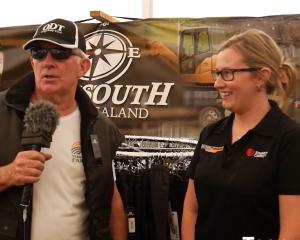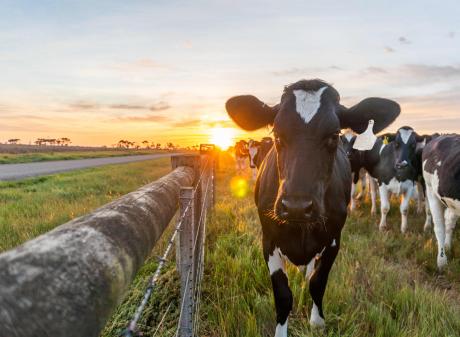
MSD Animal Health’s training specialist for South Canterbury & Otago, Ruth Talliss joined the couple to hear about their insights into the transformative impact of SenseHub Dairy monitoring technology on their farming operations, enhancing both productivity and work-life balance.
Could you give a brief overview of your farm?
Our farm is situated on a 151-hectare effective, dryland property in Otago, South Canterbury. This marks our second year as full-time, hands-on dairy farmers. Initially starting as 50/50 sharemilkers, we now lease the property. Our peak milk this season came from 411 crossbred cows, and we're targeting 180,000 kilograms of milk solids this year.
In terms of infrastructure, we operate a 40-aside herringbone system equipped with SenseHub, Protrack drafting, automatic cup removers (ACRs), and an automatic teat spray. We’re both fully committed to the farm, and we employ a second in command (2IC) and a relief milker. During the summer months, we also welcome a university student to join our team. Our farming system is categorised as System 3, and we prioritise pasture-based feeding. However, we do supplement with imported feed during dry and wet periods as necessary.


Why did you decide to implement the SenseHub system?
We decided to implement the SenseHub system after hearing about its benefits from conversations with friends, fellow farmers in our area, and attending Field Days events. Our first year "on the tools" showed us the challenges of traditional calving and AI processes, with nightly cow checks and daily selections being particularly intense for us and our skilled 2IC.
Since we were relatively new to dairy farming, we saw adopting technology like SenseHub as a way to speed up our learning curve and improve efficiency.
Since installing SenseHub this season, we've noticed huge improvements. We've stopped the need for nightly checks, and our six-week in-calf rate has seen a marked improvement, with fewer short returns and no burnout.
Do you have an stand out comments on SenseHub Dairy monitoring now you have experienced it for a season?
The ability to draft cows using the app from our phones, whether we're in the paddock or up the lane, has proven to be outstanding.
The integration of the Protrack gate with SenseHub technology has truly revolutionised our operations. Prior to the upgrades, manually identifying and drafting cows was a time-consuming task. With SenseHub in place, our workload has been significantly reduced, and the system has exceeded our expectations.
Looking ahead, we expect to be able to extract even more valuable information from the system as we learn more about what it can do over time.
How did your team find the training process? Were there any learning resources you favoured?
Our team found the training process excellent. It was structured into manageable, bite-sized chunks, which meant we never felt overwhelmed with too much information. Having a simple visual reference was also helpful for us.
Our preferred way to learn was to spend time working through the materials by ourselves. If we came up against any challenges, we knew we could rely on the support of our trainer. The availability of phone support, whether through the 0800 number or directly with a trainer, was perfect for helping with any queries or issues that we had.
Our local trainer was proactive in organising training sessions at key points throughout the year, and that meant that we were well prepared for each important phase of the implementation. Supporting us in this way helped us feel confident as we integrated the SenseHub system into our operations.
How does SenseHub help your team achieve your objectives?
SenseHub plays an important role in helping our team achieve our objectives in a few ways. Firstly, the collars provide valuable risk protection for our business by removing the reliance on a single individual for cow selection during AI. This really reduces the workload with mating, and frees up time and resources for other things.
SenseHub also helps us to create a healthy work-life balance, which is really important when raising a family. The system's accessibility allows us to monitor and manage operations remotely, even when we're not physically on the farm.
During calving, the Distress Alerts and Health Reports provided by SenseHub were great tools for our team. These features allowed us to quickly identify cows that needed help, stopping the need for manual checks and gave us peace of mind. We made a concerted effort to ensure that our 'on the drop' calvers and colostrum cows stayed within the readers' range for real-time monitoring, and that enhanced our ability to respond quickly to any issues that came up.
Are there any metrics or KPIs you track with SenseHub? If so, what are they?
Yes, we actively track several metrics and key performance indicators (KPIs) using SenseHub. During mating season, we regularly monitor the Anoestrus Cows Report to identify cows eligible for a CIDR program. Later in the season, we look at the Pregnancy Probability Report to gauge our progress and assess in-calf rates.
To help with our daily cow drafting during AI, we use a customised version of the Animals in Heat report. While at first, we found ourselves questioning how useful heat activity spikes were and whether we should prioritise cows with smaller spikes, in the end we trusted in the technology's capabilities to guide our decision-making process.
One KPI that we currently monitor, although not yet fully tracked, is Group Consistency. We expect to leverage this data to improve cow feeding practices in the future. For example, identifying first-calvers within the larger herd and comparing their rumination patterns to older cows will help us to tailor feeding strategies more effectively. This will be particularly valuable next season as we expect our first large intake, and we may consider providing additional rations through the feed pad as needed. All of this is made possible by the valuable information collected by the SenseHub collars.
Have there been any challenges and how have those been dealt with?
Certainly, we encountered some challenges at first, particularly in understanding the operational processes between SenseHub and our Protrack gate. We faced technical teething problems at the outset, but the customer support provided by SenseHub aftersales team guided us through those challenges easily.
Once the collars were on our cows, we dedicated considerable effort to updating Electronic Identification (EIDs) and tags to make sure we had smooth daily drafting processes.

Is there any advice that you would give to someone who is thinking about starting their SenseHub journey? Any tips or tricks you wish you could tell your past self?
Absolutely! Our advice to anyone considering starting their SenseHub journey is: don't hesitate—dive right in! It truly has the potential to revolutionise your life and your farm operations. The work-life balance that everyone talks about? Well, SenseHub collars have been instrumental in unlocking that door for us.
When making the decision to implement collars, allow yourself plenty of lead-in time before the start of mating season. Take the time to familiarise yourself with the system and its capabilities as much as possible. From sales and installation to ongoing support, the SenseHub team has been exceptional every step of the way.















